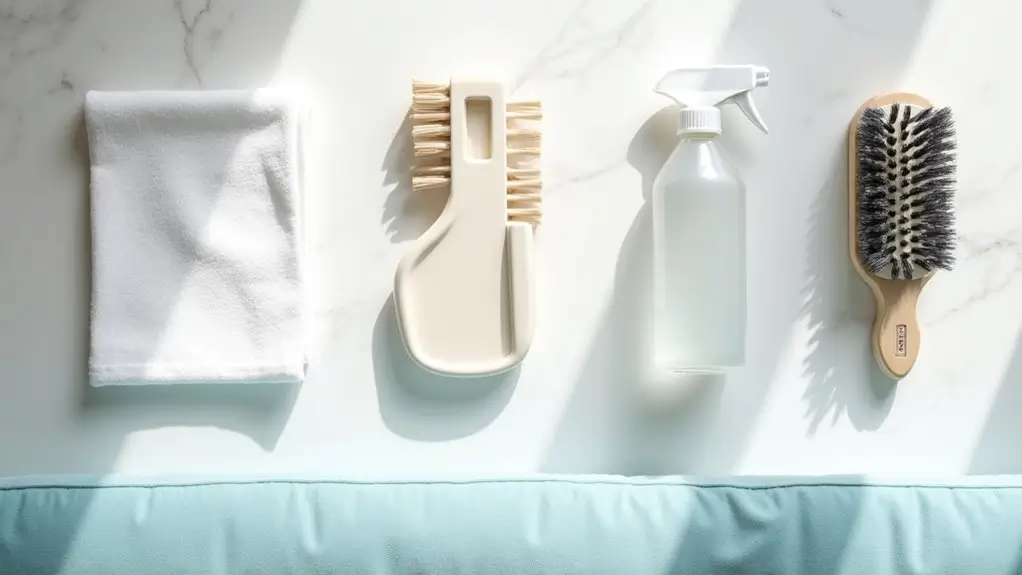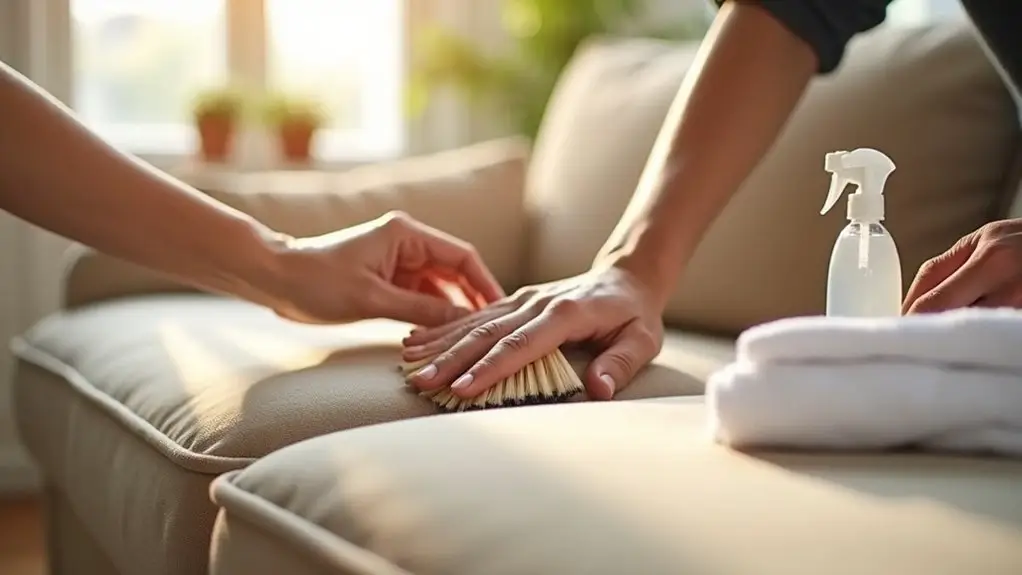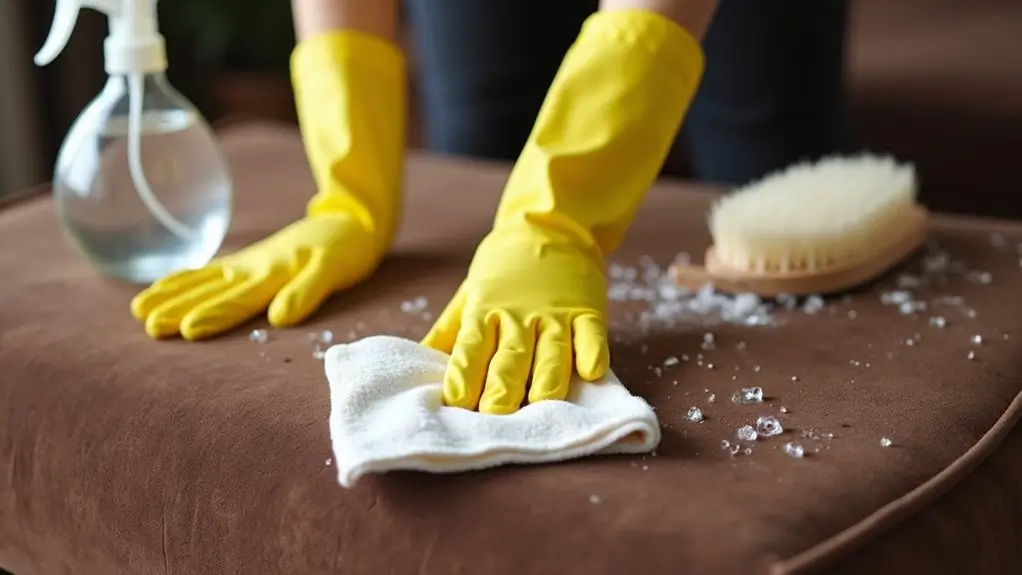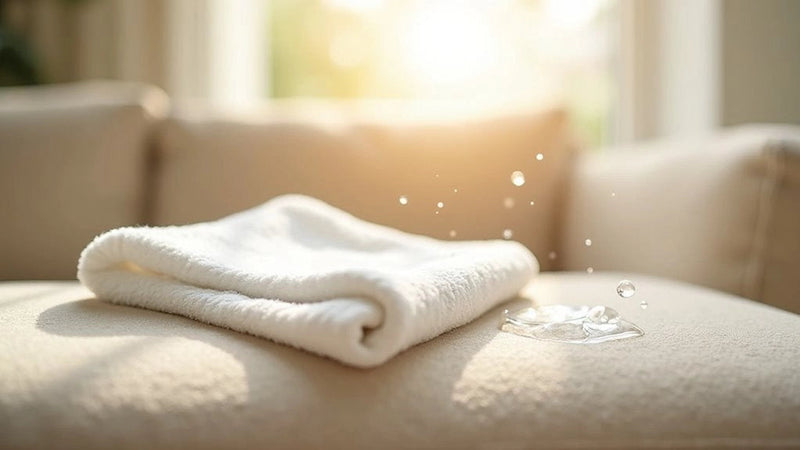Your microsuede couch won't stay pristine forever, but you don't need professional help to keep it looking fresh. Whether you're dealing with daily dust, pet hair, or that accidental wine spill, there's a simple, effective way to tackle each challenge. With the right supplies and techniques, you'll protect your investment and extend your couch's life span. Let's start with the essential tools you'll need before moving on to the cleaning methods that'll transform your sofa.
Key Takeaways
- Vacuum the entire couch thoroughly with an upholstery attachment to remove loose dirt, debris, and pet hair.
- Check the couch's care tag for cleaning codes, then test your chosen cleaning solution in a hidden spot first.
- Use a slightly damp microfiber cloth with appropriate cleaning detergent, working in small sections with gentle circular motions.
- Blot spills immediately with clean microfiber cloths rather than rubbing to prevent damage to the fabric.
- Allow the couch to dry completely in a well-ventilated area, then brush the fabric to restore its texture.
Essential Supplies and Preparation Steps

Before tackling your microsuede couch cleaning project, five essential items should be ready: a vacuum with upholstery attachment, microfiber cloths, a soft-bristle brush, cleaning detergent appropriate for your couch's code, and a spray bottle for solution application.
First, locate your couch's care tag to identify the cleaning code - this will determine which cleaning solution you'll need.
Next, make certain you're working in a well-ventilated area to allow proper drying. Before applying any cleaning solution, perform a spot test in an inconspicuous area to check for colorfastness and fabric reaction.
You'll want to thoroughly vacuum the entire surface to remove loose debris and dirt. Following the manufacturer's instructions carefully will help preserve your microsuede's texture and appearance while guaranteeing effective cleaning results.
How to Clean a Microsuede Couch

To keep your microsuede couch looking pristine, you'll need to vacuum weekly with an upholstery attachment and immediately address any spills by blotting (never rubbing) with a clean microfiber cloth.
You should always test cleaning detergents on a hidden area first to guarantee they won't damage your couch's fabric.
Keep a stiff fabric brush nearby to restore the microsuede's texture after spot cleaning, maintaining its plush appearance between deep cleanings.
Vacuum Weekly for Freshness
Regular vacuuming stands as the cornerstone of microsuede couch maintenance.
You'll need to vacuum your microsuede couch weekly using an upholstery attachment to effectively remove crumbs, dirt, and pet hair that accumulate on the surface.
Make it a habit to clean your couch every time you vacuum your floors, ensuring no debris gets left behind.
To maintain your couch's pristine condition, establish a strict no-pets rule to minimize wear and preserve the fabric's integrity.
By keeping your couch's surface free of debris through consistent vacuuming, you'll reduce the need for deep cleaning sessions and extend your furniture's lifespan.
This simple yet effective routine will keep your microsuede couch looking fresh and inviting.
Quick Spills Need Action
When accidents happen on your microsuede couch, swift action makes the difference between a permanent stain and a quick fix. You'll need to address spills immediately to prevent them from setting into the fabric.
Keep a clean microfiber cloth and baby wipes nearby for quick response to unexpected messes.
Here's what you need to do when spills occur:
- Wipe the spill immediately using a slightly damp microfiber cloth
- Gently blot the affected area - never rub or scrub aggressively
- Clean the entire section with consistent, gentle pressure to avoid water spots
Remember to test any cleaning method on a hidden area first to guarantee it won't damage your couch's microsuede fabric.
Spot Test Hidden Areas
Before applying any cleaning detergent to your microsuede couch, performing a spot test in a hidden area stands as your essential first line of defense against potential damage.
Select a discreet spot on your microsuede couch and apply a small amount of your chosen cleaning solution using a clean, white microfiber cloth. Don't use colored cloths, as they can transfer dyes onto your fabric.
If you're using a water-based detergent on microsuede, watch carefully for any adverse reactions. Wait 15-20 minutes to see how the fabric responds to the cleaning agent.
You'll want to repeat this spot test process whenever you introduce new cleaning products to your maintenance routine. This careful approach helps prevent discoloration, water damage, and unwanted staining across more visible areas of your couch.
Blot Never Rub Stains
Quick action with the right technique prevents permanent stains on your microsuede couch. When dealing with spills, remember that blotting is essential - never rub the fabric as this can damage fibers and spread the stain further. Use a clean microfiber cloth to gently press down and absorb the liquid.
- Start with a dry cloth for initial spot cleaning, applying gentle pressure to lift the spill.
- If needed, lightly dampen your cloth with rubbing alcohol for stubborn stains.
- Keep baby wipes nearby for quick response to small spills.
- Use a soft-bristled brush to restore the nap after the area dries completely.
When using any cleaner, work from the outside of the stain toward the center to prevent spreading. This technique helps maintain your microsuede's texture while effectively removing unwanted marks.
Keep Brushes Handy Always
Maintaining a microsuede couch requires having the right tools within arm's reach for daily care and unexpected spills.
Keep a stiff fabric brush as your primary cleaning method to loosen dirt and restore your upholstery's texture whenever it looks matted. You'll also want to store microfiber cloths and baby wipes in an easily accessible container to spot clean spills before they become stubborn stains.
When you notice any spills, remember to blot them gently with your cleaning tools - never rub, as this can damage the fabric and spread the stain further into the material.
Deep Cleaning Methods and Expert Tips

Start your deep cleaning process by thoroughly vacuuming your microsuede couch to remove loose debris before applying any cleaning detergents that match your couch's cleaning code.
You'll want to test your chosen cleaning method on a hidden spot first, then work in small sections using gentle circular motions with appropriate cleaning solutions for tough stains or a steam cleaner for water-safe fabrics.
Allow your couch to dry completely for 15-20 minutes after cleaning to prevent moisture-related issues like mildew or water spots.
Vacuum First, Then Clean
Before diving into deep cleaning your microsuede couch, a thorough vacuum with an upholstery attachment serves as your essential first step.
You'll need to cover every surface to verify maximum debris removal before proceeding with any cleaning solutions.
Follow these steps for effective preparation:
- Use your vacuum's upholstery attachment to remove loose dirt, crumbs, and pet hair from all surfaces, including crevices.
- Run a stiff fabric brush across the material to restore texture and dislodge embedded debris.
- Check your couch's cleaning code to determine the appropriate cleaning solution.
- Test your chosen cleaning method on an inconspicuous area to verify it won't damage the durable microsuede material.
This thorough preparation verifies your deep cleaning efforts will be more effective and safer for your furniture.
Remove Tough Stains Effectively
When tough stains appear on your microsuede couch, swift action with the right cleaning method makes all the difference. Start by blotting the stain immediately with a microfiber cloth to prevent it from setting into the fabric.
For solvent-based cleaning, apply rubbing alcohol with a cotton cloth, gently blotting to lift stubborn stains. If you're dealing with oil-based marks, use vinegar first to break down the grease, then follow with your approved solvent-based cleaner.
For particularly resistant stains, consider using a steam cleaner or a mixture of water, vinegar, and baking soda but always test in a hidden spot first.
Ensure proper ventilation while you clean a microsuede couch, and let the fabric thoroughly dry for 15-20 minutes before use. This prevents water spots and maintains the fabric's texture.
Use Steam Cleaning Method
Steam cleaning offers a powerful solution for deep-cleaning your microsuede couch, especially after addressing individual stains. This method uses high-temperature steam to penetrate deep into the fabric fibers, effectively lifting embedded dirt without oversaturating your sofa.
Before you begin the steam cleaning method, follow these essential steps:
- Test the heat sensitivity of your fabric in an inconspicuous spot to prevent damage.
- Set your steam cleaner to low pressure and maintain a 6-inch distance from the surface.
- Work in small sections, moving methodically across the sofa's surface.
- Follow up with a soft-bristle brush to restore the fabric's texture once steam has evaporated.
Allow your couch to air dry completely in a well-ventilated area, avoiding direct sunlight to preserve the fabric's color and integrity.
Test Cleaning Detergents First
Testing cleaning detergent properly can make the difference between restoring your microsuede couch and permanently damaging it.
Before applying any cleaning detergent to your couch, you'll need to conduct a spot test in an inconspicuous area.
Choose a hidden section of your couch and apply a small amount of your selected cleaning detergent using a clean, non-colored cloth.
Work the solution in a circular motion, then wait for the test area to dry completely.
Watch for any discoloration or adverse reactions while the moisture evaporates.
If you don't notice any damage after the area has dried, you can proceed with cleaning the stained sections using the same method.
Proper Drying Techniques Matter
Proper drying techniques after cleaning your microsuede couch determine the final outcome of your cleaning efforts.
When you clean a microfiber couch, it's essential to manage the drying process carefully to protect the fabric and restore its original texture.
- Position your couch in a well-ventilated area away from direct sunlight to air dry completely.
- Blot any remaining moisture with a clean, dry microfiber towel to guarantee even drying and prevent water spots.
- Use a fan or dehumidifier to speed up the drying process without applying damaging heat.
- Run a fine-tooth comb across the dried fabric to restore its texture and appearance.
Once your couch is thoroughly dry, apply a fabric protector to guard against future stains.
Follow the manufacturer's instructions carefully when applying any protective coating to maximize effectiveness.
Conclusion
You'll find microsuede maintenance isn't complicated when you follow these proven steps. Remember to vacuum weekly, tackle spills or stains immediately, and always test cleaning detergents on hidden areas first. Whether you're using rubbing alcohol, vinegar solution, or steam cleaning, proper drying is essential. Keep your brush handy to restore the fabric's texture, and you'll maintain your couch's appearance for years to come.


0 comments